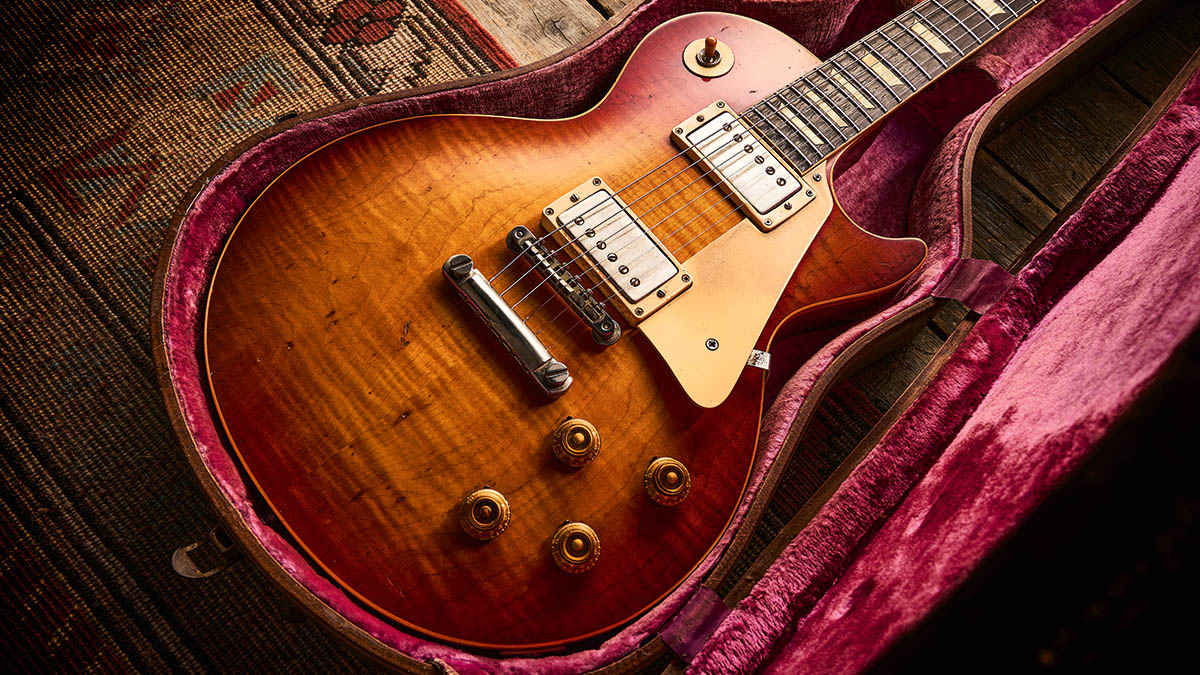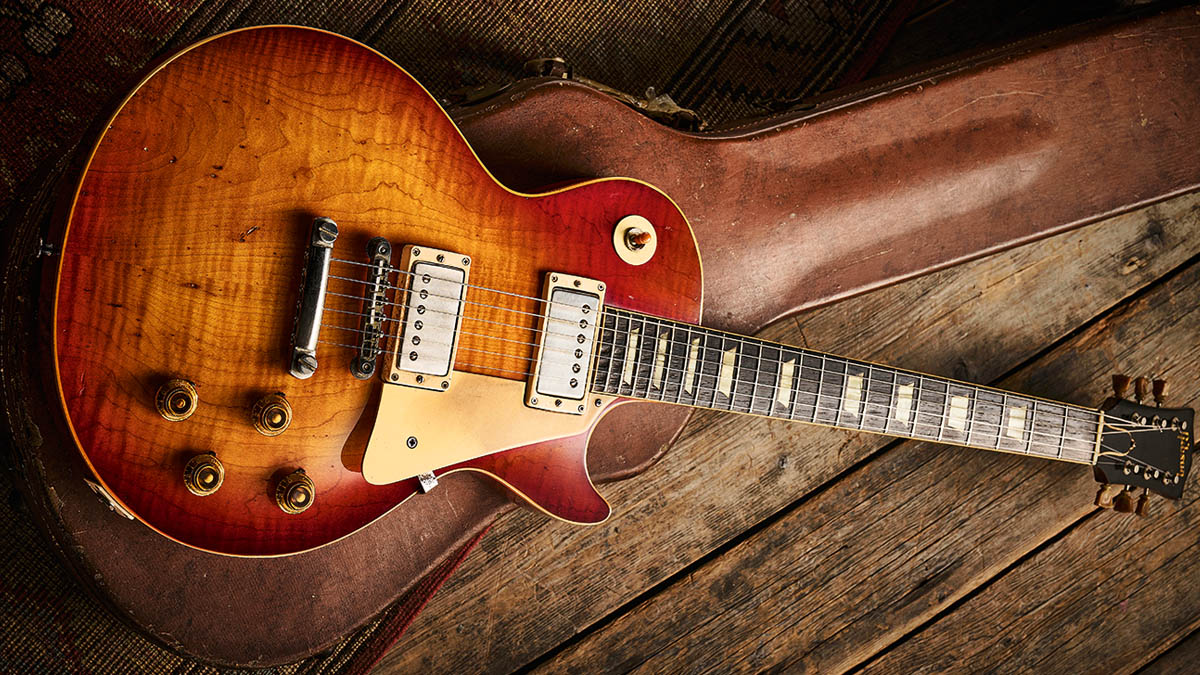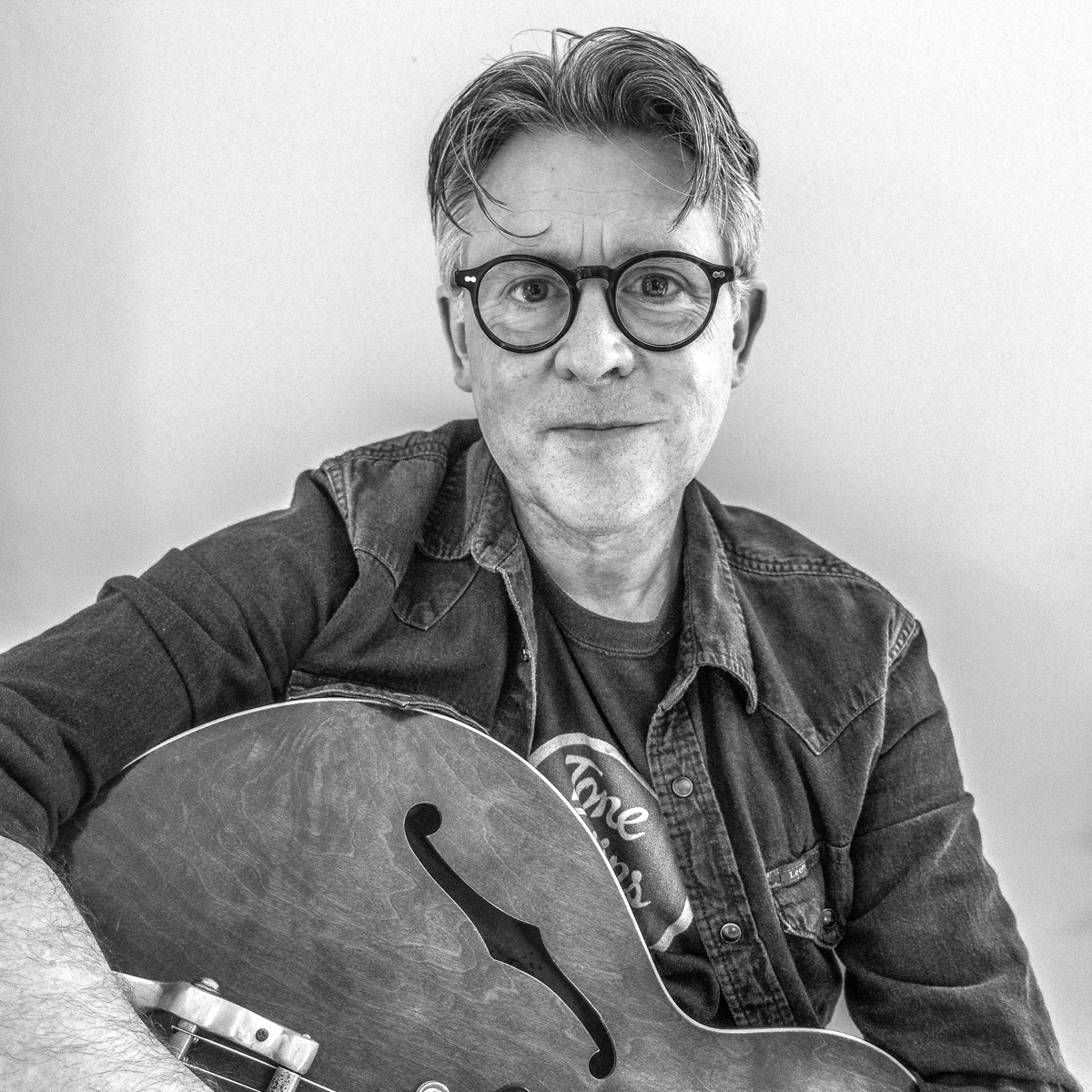
Last year, an undocumented 1960 Les Paul Standard miraculously appeared from the West Midlands in the UK.
When we interviewed Joe Bonamassa about his latest purchase, he assured us “these under-the-bed guitars are usually pristine. And they’re still around, you know.”
Well, Joe called it right because another unknown ’Burst recently turned up at Vintage ‘n’ Rare Guitars in Bath, UK.
Life partner
Henry Sylvester Andrew was never a famous rock star, but throughout his life he remained a one-guitar guy. That guitar just happened to be the Gibson Les Paul Standard he had long admired through the window of his local guitar store, Barrie’s Music in Durban, South Africa. Knowing it was his dream guitar, Henry’s wife paid the deposit as a gift soon after their marriage in 1959.
Henry began his career teaching English and history, but the school quickly appointed him to the role of music teacher. In 1977 he took up a new position, teaching children with additional medical, sensory and physical needs. He would arrange concerts for assemblies, parent days, Christmas and Easter events, always using his Les Paul. Henry’s family describe him as quiet and shy, but he loved performing in the church choir and played lead guitar with his band The Moonglows.

All of Henry’s children knew they were not allowed to touch his guitar when he wasn’t around, and it’s reported that he wouldn’t even trust it to a guitar tech. Consequently, it has remained completely original and unmodified. Vintage ‘n’ Rare Guitars actually found dust and cobwebs within the pickup cavities, so they were most likely the first to look inside since the guitar left the assembly line.
Real fanatics often bewilderingly refer to various ’Bursts simply by using their serial numbers, but, like Stradivarius violins, most have acquired nicknames. Henry Sylvester Andrew was widely known as ‘Sunny’ and given the sunburst finish’s state of preservation, Vintage ‘n’ Rare decided that ‘Sunny’ would be an appropriate name for the beloved Les Paul he left to his children when he passed away in 2021.
Get The Pick Newsletter
All the latest guitar news, interviews, lessons, reviews, deals and more, direct to your inbox!
Nothing changes
Sunny is remarkable even by ’Burst standards (no pun intended) because it’s in such astonishing condition and retains its case and all its original parts. The tuners have been changed, but only because the original buttons have shrunk to the point where they’re starting to crumble.

A set of vintage Klusons has replaced them, but the originals remain with the guitar and they’re a new set of buttons away from full functionality. Vintage ‘n’ Rare also decided to retire the slightly damaged jack plate while it was still just about hanging on, and fit a period-correct repro.
This guitar has never suffered a headstock break and the control wiring appears to be untouched. The neck pickup’s hot connection does protrude through the volume control’s solder tag, but the solder joint is dull rather than shiny, which suggests age, and the braided wires have the appearance of a factory layout.
All four potentiometers are original and the ‘bumblebee’ capacitors are the earlier oil-filled type. Vintage ‘n’ Rare also confirmed that the pickups are original and that the covers had never been removed.
Telling stories

If you take time to read the runes, every vintage guitar carries the story of its life and Sunny has clearly had a lot of use and an equal amount of love. Lacquer has worn away on the back of the neck through playing, and it’s largely confined to the area between the nut and the 7th fret.
This is consistent with extensive ‘tramlining’ along those frets and minimal fretwear above. The guitar arrived at Vintage ‘n’ Rare with a rusty set of wound G strings and the fretboard displays a fair amount of plectrum wear in between the top six frets, so we might conclude that Henry was mainly a rhythm guitar man.
Sunny is far from unique as an unmolested ’Burst, but the condition of the lacquer does put it in a class of its own
Sunny is far from unique as an unmolested ’Burst, but the condition of the lacquer does put it in a class of its own. During 1959, Gibson was still using aniline red pigment, which fades with alarming speed when exposed to sunlight. Considering the climate in South Africa, it seems likely that Sunny lived in a closed case when Henry wasn’t playing it.
There is some fading, but the red remains unusually vibrant, and ambered top coats combined with a vivid yellow centre have given Sunny’s top an extraordinary warmth and depth. A lifetime in South Africa has also protected this guitar from extreme temperature fluctuations, so the lateral lacquer cracks that are usually present on Gibsons from this era are completely absent.
There is one small area of checking on the front, but the crazed pattern seems more consistent with an unfortunate encounter with a dry ice machine. The only thing resembling ‘damage’ is an area of long, deep scratches on the lower bout, which suggests an unfortunately positioned strap buckle.

In the hands
Contrary to popular belief, not all ’Bursts were light and they typically range from around 8lb to 10lb in weight. At 8lb 11oz, Sunny is towards the lighter end of the spectrum and pretty much ideal from a playing perspective. We would describe the neck as having a quintessentially 1959 profile that manages to disappear into the crook of your hand despite being quite substantial.
There’s nothing clubby about it and the depth remains fairly consistent all the way up to the 12th fret
There’s nothing clubby about it and the depth remains fairly consistent all the way up to the 12th fret. There’s the merest hint of a V at the headstock end, and while the neck does gradually round out, it never feels bulbous. As you’d expect from a really good ’Burst, the whole package feels immensely playable and supremely comfortable.
With the upper frets displaying so little playwear, it’s a great opportunity to take some measurements. For the record, original 1959 ’Burst wire measures 0.1 inches (2.54mm) wide and height readings average out around 0.035 inches (0.889mm) on Sunny. If you’re looking for a modern equivalent, Jescar FW 45100 is the closest we have found and FW51100 provides a slightly taller option.
Bloomin’ ’Bursts
During a recent chat with Aynsley Lister, he made the point that sonic differences tend to be more apparent between Stratocasters than any other guitar model. He cited brightness, dynamic response and the midrange characteristics, and it’s hard to argue with that, so long as vintage Les Paul Standards are excluded from the debate.

Our experience of vintage ’Bursts has demonstrated that they also vary dramatically. Granted, there are qualities that the vast majority have in common, but suggesting there’s any such thing as ‘’Burst tone’ per se would be an oversimplification. With that in mind, Vintage ‘n’ Rare kindly agreed to let us use Andrew Raymond’s Grainger ’Burst to compare. Both guitars were played through a Sundragon Limited Edition Combo – a painstaking recreation of Jimmy Page’s favourite recording amp.
Chris Buck has described Grainger as his favourite ’Burst and it’s notable for combining brightness and clarity with real amp pushing power and a very cleanly defined attack. In contrast, Sunny dishes out a darker grind, with softer transients but no shortage of clarity.
‘Bloom’ has frequently been used to describe another ’Burst characteristic when upper harmonics become audible as notes are sustained. So long as the original pickups are still onboard, they all do it to some extent, but the manner in which the bloom develops does vary. Typically, harmonic overtones fade in gradually, and with some ’Bursts you get multiple harmonics drifting in and out. When playing Sunny, the bloom occurs almost instantaneously and the harmonics are very pronounced.

The bridge pickup has Pearly Gates-like thick mids and an adenoidal cocked-wah quality that produces strong powerchords and morphs into quacky cleans when the volume control is backed off. Unlike Grainger, Sunny doesn’t quite pull off the pseudo Tele trick, but it does retain clarity and definition.
The neck pickup doesn’t quite match Grainger’s distinctive pick attack, but it’s fat, vocal and expressive. There’s a flutey smoothness that can make you feel like the guitar is playing itself, and it cleans up to produce jazzy chord voicings and mellower blues tones.
It delivers the effortless sustain that has made guitarists go gaga for ’Bursts since the mid-’60s
But best of all, it delivers the effortless sustain that has made guitarists go gaga for ’Bursts since the mid-’60s. These days, it’s easy enough to get guitars to sustain using high-gain amps or pedals, but ’Bursts can generate almost otherworldly sustain – even plugged straight in at low-ish volumes with medium gain – and Sunny does it as well as any of them.
It can sometimes catch you by surprise and when the guitar decides to grab onto a note it’s fun just to hang on for the ride. We can’t imagine Sunny’s new owner is going to be disappointed.
More to come
Following on from ATB’s discovery in 2021, auctioneers Dore & Rees sold another under-the-radar ’Burst that had belonged to a guitarist called James Llewellyn Morgan since 1972. That same year, another one-owner 1960 ’Burst, now known as Rosie, showed up in Illinois and ended up in Denmark. With a bit of research, you can soon find other examples, so something is clearly shifting.
It’s entirely possible that we might be seeing surprising numbers of undocumented ’Bursts coming to light over the next few years
With values at historic highs, could it be that some long-time owners have decided it’s the right time to sell? There’s also the sad fact that many of the players who bought these guitars back in the 1960s and ’70s are coming towards the end of their lives and maybe the money is needed for other things. Those who have already died may have left valuable instruments to family who are choosing to sell and split the proceeds.
It’s entirely possible that we might be seeing surprising numbers of undocumented ’Bursts coming to light over the next few years. Going by the figures on BurstSerial.com, Les Pauls that were produced between 1958 and 1960 number about 1,700 and that includes Goldtops and early SGs. They have only managed to log around half of them, so, as Joe said, it does seem that they’re still around…
- Guitarist would like to thank Vintage ‘n’ Rare Guitars for showing us this incredible guitar.
Huw started out in recording studios, working as a sound engineer and producer for David Bowie, Primal Scream, Ian Dury, Fad Gadget, My Bloody Valentine, Cardinal Black and many others. His book, Recording Guitar & Bass, was published in 2002 and a freelance career in journalism soon followed. He has written reviews, interviews, workshop and technical articles for Guitarist, Guitar Magazine, Guitar Player, Acoustic Magazine, Guitar Buyer and Music Tech. He has also contributed to several books, including The Tube Amp Book by Aspen Pittman. Huw builds and maintains guitars and amplifiers for clients, and specializes in vintage restoration. He provides consultancy services for equipment manufacturers and can, occasionally, be lured back into the studio.
“It holds its own purely as a playable guitar. It’s really cool for the traveling musician – you can bring it on a flight and it fits beneath the seat”: Why Steve Stevens put his name to a foldable guitar
“Finely tuned instruments with effortless playability and one of the best vibratos there is”: PRS Standard 24 Satin and S2 Standard 24 Satin review











